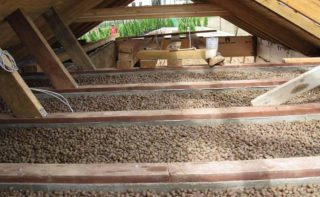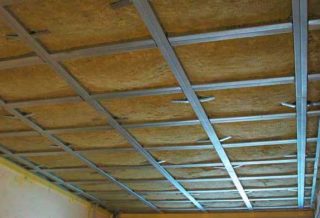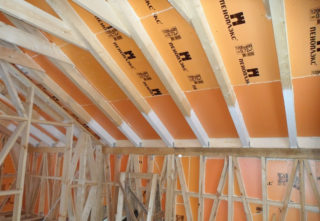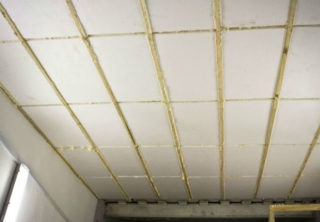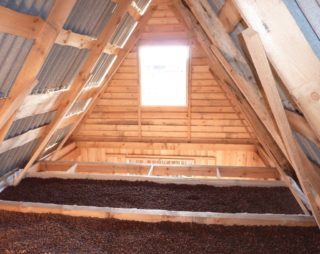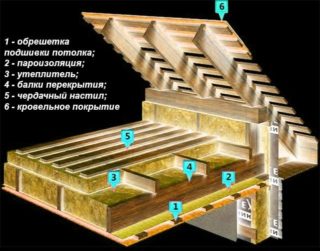In winter, the level of heat loss due to the cold roof reaches 25%, because of this it is necessary to load the heating system, which causes the consumption of coolants. The budget option to solve the problem is the insulation of the ceiling. Its area is smaller compared to the roof, it will not need much material. It is important to choose the best option for thermal insulation and suitable insulation, this will determine the positive result as a whole.
When to insulate the ceiling
Experts recommend conducting any construction work in the summer, this period is considered the most suitable. Warm and dry weather significantly facilitates the repair process. It is also worth considering the limitations associated with certain materials that dry at a certain temperature, as well as drying surfaces and additional factors.
Sometimes they depart from these rules if it comes to the need to urgently insulate the ceiling. In this case, any time will come before the onset of severe colds, when a suitable opportunity arises. Heat losses in winter provoke drafts and heat energy consumption, so the installation of ceiling ceilings is an important and necessary measure, which is best carried out before severe frosts occur. First you need to choose the best insulation for the ceiling and decide who will carry out the work: the owner of the house or builders.
Selection of insulation
When choosing materials for ceiling insulation in any private house, it is recommended to choose an option that is included in one of four groups:
- mineral, basalt or glass wool;
- clay, sawdust, expanded clay and vermiculite;
- polymers made from foamed polyethylene or polystyrene;
- sprayed insulation - ecowool, liquid foam and polyurethane foam.
The last group requires the necessary equipment and the ability to work with it, so such an installation will be difficult to carry out independently in the absence of the necessary skills.
Choosing the right option is necessary taking into account the characteristics of the premises, the needs and budget of the owners of the house. For complete insulation, a structure is constructed that includes an insulating layer with a frame and a finished coating for the cladding. A well-made insulation for the ceiling or a cold attic helps maintain a comfortable temperature in the room at any time of the year, as well as significantly reduce heating costs. Everyone who plans to carry out this procedure should adhere to the recommendations:
- maintain optimal steam circulation to minimize heat loss;
- prevent condensate from getting into the insulation;
- Use only fireproof and environmentally friendly materials, such as sawdust.
Before choosing a material, they decide whether it is advisable to lower the ceiling or its height should be maintained at the same level. The speed of the work and the current time of the year also matters.
Minvata
Minvata will be a good choice for those who are looking for a budget option. Cotton wool is sold in the form of plates and rolls, it is very convenient to use, it also has a high level of fire resistance and is able to prevent the spread of flame inside the house in case of fire. Its small weight is added to the list of advantages of rolled minvata, which allows you to carry out the work yourself in the absence of outside help.
Vata has a structure in the form of fibers, so it provides the highest quality sound and thermal insulation. The synthetic composition is not affected by rodents and insects, mineral wool will serve as long as possible and will retain its properties for many years. This is an environmentally friendly and safe material, especially if ecowool is used, which is odorless and suitable, including for ceilings in children's rooms.
Penoplex
EPSS or penoplex has good chemical and physical properties, it is well suited for brick or wooden roofs, including the ceiling in a bathhouse, steam room and garage. The material also belongs to the category of environmentally friendly, has a porous texture and a low level of water absorption in combination with normal vapor permeability. Penoplex is not susceptible to mold and does not respond to contact with the environment, which eliminates possible rotting.
Plates of foam are quite dense and able to withstand the highest loads, so this material can cover not only the ceiling, but also the walls and floor. Each plate has a convenient shape and is equipped with an L-shaped protrusion, due to which installation is noticeably simplified. The surface of the plates is rough, which provides excellent adhesion to any finishing material, for example, plaster. Also, due to the acceptable weight, penoplex is not able to weight the structure of the floors.
Styrofoam
If you need to inexpensively insulate the ceiling, it is worth considering foam material as a material. It is universal, lightweight and sold at an affordable price. Experts note its high thermal insulation properties. This is a durable material, not subject to damage from insects and rodents, the development of rotting, mold, as well as other factors. Polyfoam is not toxic. Does not cause installation difficulties even for beginners.
The composition of the material contains foamed plastic masses with a high gas content, which determine the increased density, lightness, good sound insulation qualities. Using polystyrene foam, one can noticeably save in comparison with insulation with glass wool or mineral fiber. With the help of polystyrene, the ceiling and walls can be insulated.
Which side is the ceiling insulated
Install thermal insulation and cover the coating can be inside or out. Each method has its advantages and disadvantages, which are necessarily taken into account. According to experienced builders, the best option is external insulation, so the upper ceilings should be insulated from the attic side, after selecting the appropriate material for this purpose. This method is very effective for many reasons:
- ease of installation, especially if the work is done manually, no need to build a suspension frame or hem insulation from the underside to the ceilings;
- a small insulator layer with a thickness of not more than 10-20 cm is not able to affect the height of the premises, this is a bonus for houses with low ceilings;
- lack of need to remodel repairs in a residential building or apartment;
- if the rules of thermal insulation are not observed from the inside, the layer under the heater gets wet, which contributes to the development of the fungus.
The ceilings of the attics, loggias or balconies, the ceiling of the concrete garage above the cellar or basement are not insulated from the outside. In these cases, thermal insulation of the internal type is carried out with strict observance of the rules and instructions.
Preparing for insulation
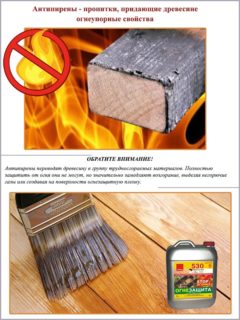 The preparation process depends on the material of which the ceiling is made. It can be wooden or concrete. If the ceiling is made of wood, before work the surface is treated with an antiseptic primer, which should have a flame retardant effect.The coating is applied as thoroughly as possible, lowering the brush, including between the spaces in the boards. In the second stage, you will need to glue all the gaps with a putty suitable for wood. For large gaps, foam is used, when it hardens, the excess is carefully cut with a knife.
The preparation process depends on the material of which the ceiling is made. It can be wooden or concrete. If the ceiling is made of wood, before work the surface is treated with an antiseptic primer, which should have a flame retardant effect.The coating is applied as thoroughly as possible, lowering the brush, including between the spaces in the boards. In the second stage, you will need to glue all the gaps with a putty suitable for wood. For large gaps, foam is used, when it hardens, the excess is carefully cut with a knife.
A surface of concrete or aerated concrete is prepared in another way. If there is an old coating, it is removed, because a new even layer should be laid on this place. If the plaster is applied qualitatively, it is not removed, exfoliating places need to be cleaned. If there are cracks on the surface, they are expanded and then cleaned with soft brushes, then treated with a primer. Small cracks can be filled with cement mortar or sealant; for wide cracks, it is better to use mounting foam.
At the final stage of preparation, the concrete ceiling is covered with a primer. This helps to strengthen the adhesion of the ceiling and insulation.
How to properly insulate the ceiling
The installation method can be considered on the example of attic insulation with foam. With external insulation according to the standard scheme, first of all, you will need to completely empty the attic from unnecessary things. The area of space must be measured in order to accurately calculate the amount of material. The free area is completely covered with polystyrene foam, the seams are fastened with mounting foam. Pouring the screed at the final stage is necessary only if the attic is often walked on. Before pouring screeds on all sheets put a reinforced mesh with a layer width of at least 50 mm. When warming with foam, claydite is often used as a screed because of its high reliability and low weight.
The process of insulation begins with steam and waterproofing. For this purpose, layers of roofing material, foil or plastic film are fixed on the ceiling. The selected material is divided into strips with a width of at least 10 cm, on average, this value should be greater than the distance of the outstretched arm or one meter and the gap that is between the overlapping beams. If the ceiling is large, the overlap on the walls can be no more than 12 cm. The seams that form between pieces of material are processed using special tapes that should fit snugly against the edges.
If roofing material is used, it is glued using rubber-bitumen mastic; aluminum or standard adhesive tape is suitable for foil and film. Additionally, they lining the rafters and the chimney pipe, fixing the material for vapor barrier above the location of the main layer. All canvases are fixed using tape or a construction stapler. Sometimes clay is laid on top of the vapor barrier, its layer contributes to additional insulation of the entire structure.
You can lay off and insulate the ceilings yourself, if you use the simplest material. In the absence of the necessary skills and knowledge, it is better to entrust this procedure to professionals.
Insulation layer thickness
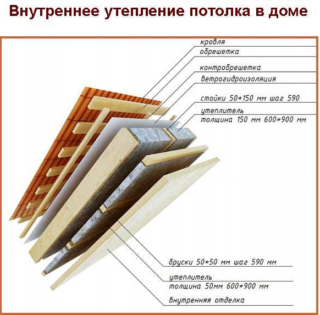 It is important to correctly determine the minimum layer thickness for insulation of the ceiling, in order to provide the necessary resistance to heat transfer over a cold attic. For this purpose, you can use a special calculator or carry out calculations yourself. First of all, they draw a diagram of the ceiling in the house, indicate the materials used and the thickness of all layers that will enter the ceiling. Manual calculations are much more difficult, also in this case it is worth considering the possible errors and errors.
It is important to correctly determine the minimum layer thickness for insulation of the ceiling, in order to provide the necessary resistance to heat transfer over a cold attic. For this purpose, you can use a special calculator or carry out calculations yourself. First of all, they draw a diagram of the ceiling in the house, indicate the materials used and the thickness of all layers that will enter the ceiling. Manual calculations are much more difficult, also in this case it is worth considering the possible errors and errors.
The options for the schemes can be different, regardless of the type chosen, it will be necessary to determine the desired value of the heat transfer resistance depending on the region of residence. You can find a suitable calculator on the Internet, they indicate the type and thickness of the floors, finishes, flooring and insulation material, as well as the value of heat transfer resistance.For examples, different types of insulation are introduced to understand which variety is best suited.
The choice of material and installation method depends on the physical and financial capabilities, but in any case it is better to give preference to natural raw materials with optimal parameters. This will help to avoid possible problems and create the most comfortable climate in the room.
